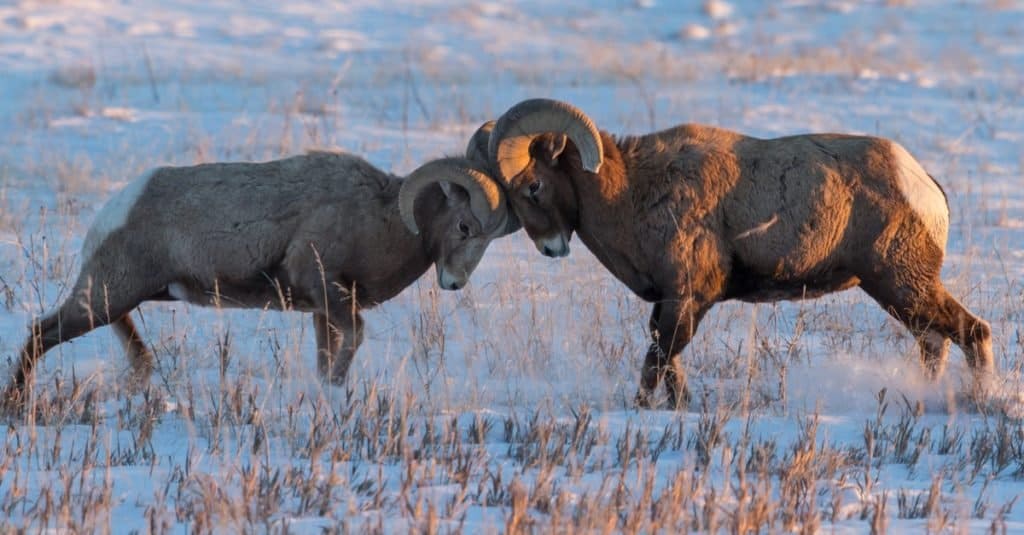Bighorn Sheep
.jumbotron {
background-image: url(“https://a-z-animals.com/media/2021/06/Bighorn-Sheep-header-2-400×300.jpg”);
}
}
@media only screen and (min-width: 641px) and (max-width: 920px) {
.jumbotron {
background-image: url(“https://a-z-animals.com/media/2021/06/Bighorn-Sheep-header-2-470×370.jpg”);
}
}
@media only screen and (min-width: 921px) {
.jumbotron {
background-image: url(“https://a-z-animals.com/media/2021/06/Bighorn-Sheep-header-2.jpg”);
}
}
Bighorn Sheep
Ovis canadensis
Bighorn rams can run at speeds up to 40 miles per hour when fighting for dominance.
Bighorn Sheep Scientific Classification
- Kingdom
- Animalia
- Phylum
- Chordata
- Class
- Mammalia
- Order
- Artiodactyla
- Family
- Bovidae
- Genus
- Ovis
- Scientific Name
- Ovis canadensis
Read our Complete Guide to Classification of Animals.
Bighorn Sheep Conservation Status
Bighorn Sheep Facts
- Name Of Young
- lamb
- Group Behavior
-
- Herd
- Fun Fact
- Bighorn rams can run at speeds up to 40 miles per hour when fighting for dominance.
- Estimated Population Size
- 70,000
- Biggest Threat
- Man
- Most Distinctive Feature
- Big horns
- Other Name(s)
- Rocky Mountain sheep, bighorn
- Gestation Period
- 177 days
- Litter Size
- 1
- Habitat
- Mountainous grasslands
- Predators
- Mountain lions, wolves, bobcats, coyotes and golden eagles
- Diet
- Herbivore
- Favorite Food
- Plants and shrubs
- Type
- Mammals
- Common Name
- Bighorn Sheep
- Number Of Species
- 1
- Location
- Western mountainous regions of North America
- Group
- Herd
Bighorn Sheep Physical Characteristics
- Color
-
- White
- Dark Brown
- Grey-Brown
- Skin Type
- Hair
- Top Speed
- 18 mph
- Lifespan
- 10-15 years
- Weight
- 34kg-143kg (74lbs-315lbs)
- Height
- 74cm- 104cm(29in-41in)
- Length
- 140cm-200cm (55in-79in
- Age of Sexual Maturity
- 24 months
- Age of Weaning
- 6 months
This post may contain affiliate links to our partners like Chewy, Amazon, and others. Purchasing through these helps us further the A-Z Animals mission to educate about the world’s species..

Spiders that fly! Fish that walk! And 1000+ more incredible animals. Discover them all for FREE
.photo-gallery {
–margin: 0px auto 0px;
–padding: 0px 0px 0px 0px;
}
.gallery-link {
background-image: url(“https://a-z-animals.com/media/2021/06/Bighorn-Sheep-close-up-1024×535.jpg”);
background-repeat: no-repeat;
background-size: cover;
background-position: center;
height: 500px;
justify-content: center;
text-align: center;
align-items: center;
display: flex;
border: 2px solid #000;
}
.gallery-link img {
height: 50%;
}
@media only screen and (max-width: 768px) {
.gallery-link {
height: 300px !important;
}
}
View all of the Bighorn Sheep images!
Bighorn sheep live in the United States, Canada, and Mexico.
There are different subspecies of bighorn sheep, but they all have big horns. Some live in the desert while others live in the mountains. The facts are that at least two populations of bighorn sheep may soon be extinct.
5 Incredible Facts About Bighorn Sheep!
- These sheep live in the Rocky Mountains and the Sierra Nevada ranges of the United States, Canada, and Mexico.
- Bighorn sheep rams use their horns to ram each other to determine dominance, but they seldom hurt each other.
- They live in same-sex herds.
- Bighorn sheep put on a second coat over their summer coats to stay warm in the winter.
- Dall sheep have the same scientific name as bighorn sheep.
Bighorn Sheep Scientific Name
The scientific name of these sheep is Ovis canadensis. They belong to the Artiodactyla order, including pigs, sheep, goats, cattle, deer. These sheep belong to the Bovidae family and the Caprinae subfamily.
This scientific name covers two species. The Bighorn sheep and the Dall sheep who live in Alaska and northern Canada.
Bighorn sheep can be divided into three subspecies:
- Ovis canadensis sierrae – This subspecies lives in California’s Sierra Mountain range.
- Ovis canadensis nelsoni – This subspecies lives in the desert in the Southwestern United States and Northwestern Mexico
- Ovis canadensis canadensis – This subspecies lives in the Rocky Mountains in Canada and throughout the Northwestern United States.
Bighorn Sheep Appearance
These sheep vary a little by subspecies. Rocky Mountain sheep are the biggest wild sheep in North America. Males weigh about 300 pounds. These animals stand about 42-inches tall at their shoulders or about the same height as a typical kindergartener. They grow to be about 5.5-feet long.
Females are smaller than rams. They generally weigh about 33-inches tall. That is about the same size as an average 2-year-old. Rams usually weigh about 135 pounds or almost as much as a small English Mastiff bitch.
Rocky Mountain sheep has a greyish-brown coat that turns darker in the summer. Additionally, Rocky Mountain sheep who live in Canada usually have a darker coat than those who live in the United States. These animals have a white patch on their rump and their inner legs and muzzle.
These animals have several adaptations that help them survive. They develop a thick winter coat over their summer coat. Their hooves are made in two parts, which allows them to keep their footing in mountainous terrain. Each part contains a soft inner material helping them walk on uneven ground. Their eyes are broad set, and they can see up to 1 mile, which can help them spot a predator while it is far away.
Desert sheep are usually smaller than Rocky Mountain bighorn sheep. Rams typically weigh about 220 pounds and stand about 40 inches tall. The coat on these animals is tan as opposed to brown.
Like Rocky Mountain sheep, they have cloven hooves so that they can climb in rough terrain. They have a complex digestive tract designed to get all nutrients possible out of the plants that they eat.
Generally, Sierra Nevada bighorn sheep have a large variation in their coloring. In the summer, they may appear a dark brown while they appear almost white in the winter. This is because the sun bounces off the snow, fading their coats. Rams usually weigh about 180 pounds while ewes weigh about 125 pounds.
Sierra Nevada sheep have different adaptations helping them survive. These sheep migrate to higher elevations as the temperatures warm to get the best nutrition from the plants they eat. The rump muscles are very well developed, which helps them climb steep terrain better.

Warren Metcalf/Shutterstock.com
Horns
One of the most notable features of these sheep is their horns. Both rams and ewes have horns that grow throughout their lives. Horns are made up of born covered by keratin, which is the same substance found in human hair and fingernails.
Rams usually have bigger horns than ewes. Researchers believe that the horns can weigh up to 30 pounds. Animals with bigger horns are generally older, and they are usually the dominant ones in their herd.
Desert sheep horns are smaller and have a tighter curl than those of the other species.
Bighorn Sheep Behavior
These sheep live in same-sex herds. While herds of up to 100 individuals have been reported, it is more common to have eight-to-10 individuals in a herd. Each herd has a dominant member who makes decisions for the entire herd, like a queen or a king. While young rams go off to find their male herd, usually before their first birthdays, most ewes stay and become members of their mother’s herd.
Rams butt horns with each other for domination. When they are fighting, they may charge at each other at speeds up to 40 miles an hour, although 20 miles per hour is more common. This fighting may continue for up to 24 hours, but usually, neither bighorn sheep is hurt.
These sheep are diurnal animals that are most active at sunrise and sunset. This tends to be particularly true of desert bighorn sheep who tend to try to escape the heat of the day.
Bighorn Sheep Habitat
The habitat of these sheep varies by subspecies. Rocky Mountain bighorn sheep live in the Rocky Mountain range. You can see them in alpine meadows, woodlands, mixed-grass prairies, and shrub-bunchgrass. They primarily live near bodies of water with high salt content.
Desert sheep ranges across the Mojave Desert, Sonoran Desert, Great Basin Desert, Chihuahua Desert, and the Colorado Plateau.
Sierra Nevada bighorn sheep live in upland, montane, and alpine habitats with rocky areas along the eastern slope of the Sierra Nevada Mountain range. They prefer to live in elevations from about 4,000 feet to approximately 14,500 feet. They tend to live at higher elevations during the summer months and lower elevations during the winter months.
Bighorn Sheep Diet
All of these sheep eat plants. Rocky Mountain and Sierra Nevada bighorn sheep dine on grasses, clover, and sedges during the summer months. When the weather turns colder, their diet consists of more woody plants, like willow and sage.
Desert sheep eat plants throughout the year. They have been observed eating holly and cactus.
Bighorn Sheep Predators and Threats
Coyotes, golden eagles, mountain lions, bears, and Canada lynx are predators of bighorn goats. This is especially true of lambs. Ewes often give birth to their young on narrow mountain ledges to try to protect them in mountainous areas.
One of the biggest threats to these sheep is domestic sheep raising. When domestic sheep are allowed to graze on the same land, it cuts down on available food. Furthermore, herds of domestic sheep have introduced bacteria to bighorn sheep that their system cannot handle. Therefore, whole herds have been wiped out.
While there are not many of these sheep living in Washington, this is mainly a problem in that state. Sick domesticated sheep carry the Mycoplasma bacteria. When the bighorn sheep get the bacteria, then it causes them to get pneumonia.
Bighorn Sheep Reproduction and Life Cycle
The gestation period is 5.5-to-6 months in these sheep. Most lambs are born to Rocky Mountain and Sierra Nevada sheep from late April to late June. In desert bighorn sheep, most lambs are born between January and April, but they may give birth throughout the year.
Baby lambs can climb almost as well as their mothers when they are just two days old. They are eating grass and other plants by the time that they are two weeks old. From 1-to-7 months, bighorn sheep are weaned. Ewes do not reach their full size until they are about 5.5 years old while rams do not reach their full size until they are about 6.5 years old.
The oldest Sierra Nevada bighorn sheep was 17 years old when officials saw it for the last time. Generally, the Sierra Nevada and Rocky Mountain bighorn sheep live to be about 15 years old while desert bighorn sheep live to be about 10 years old.
Bighorn Sheep Population
There are approximately 70,000 bighorn sheep in the world. The vast majority of those are Rocky Mountain bighorn sheep. Officials fear there are less than 800 Sierra Nevada bighorn sheep.
They think that there are even fewer Peninsula bighorn sheep. This group of desert sheep lives in San Diego, Riverside, and Imperial Counties in California.
View all 192 animals that start with B
Bighorn Sheep FAQs (Frequently Asked Questions)
What Are the Special Characteristics of Bighorn Sheep?
Bighorn sheep have several special characteristics, but they are best known for the big horns that they grow throughout their lives. These horns can weigh up to 30 pounds.
These animals also have special hooves. Their hooves are made in two parts, allowing them to walk on thin ledges better. Additionally, the middle of the hoof is soft to walk on the uneven ground better.
Bighorn sheep who live in cold climates have a unique coat. When it starts to get out, they grow a second coat over their summer coat. The dense winter coat helps to keep them warmer, and they will lose it in the spring.
Are Bighorn Sheep Dangerous?
Any wild animal can be dangerous, especially if it feels cornered. Ewes are especially likely to attack if they feel like their lambs are in danger. Bighorn sheep prefer to use their keen eyes to see at least 1 mile to avoid you.
What Is the Difference Between a Ram and a Bighorn Sheep?
A ram is a male bighorn sheep. Females are called ewes, and babies are called lambs.
When did Bighorn Sheep Go Extinct?
Bighorn sheep are not extinct. There are two particular groups of bighorn sheep that may go extinct soon. There are less than 800 Sierra Nevada bighorn sheep and even fewer Peninsula bighorn sheep. The facts are that it may be too late to protect either group from going extinct.
Sources
- Rocky Mountain National Park, Available here: https://www.nps.gov/romo/learn/nature/bighorn_sheep.htm
- Center for Biological Diversity, Available here: https://www.biologicaldiversity.org/species/mammals/Peninsular_bighorn_sheep/natural_history.html#:~:text=Peninsular%20bighorn%20sheep%20can%20live,wide%20variety%20of%20plant%20species.
- Animalia, Available here: https://animalia.bio/bighorn-sheep
- San Diego Zoo, Available here: https://ielc.libguides.com/sdzg/factsheets/bighornsheep/reproduction
- Bighorn Institute, Available here: https://www.bighorninstitute.org/bighorn-sheep-facts#:~:text=A.,which%20grow%20throughout%20their%20lives.&text=Young%20bighorn%20that%20are%20less,are%20referred%20to%20as%20lambs.
- Bioweb, Available here: http://bioweb.uwlax.edu/bio203/s2007/white_dere/adaptations.htm
- National Park Service, Available here: https://www.nps.gov/articles/desert-bighorn-sheep-living-life-on-the-edge.htm
- U.S. Fish & Wildlife Service, Available here: https://www.fws.gov/nevada/protected_species/mammals/species/sn_bighorn_sheep.html
- National Wildlife Federation, Available here: https://www.nwf.org/Educational-Resources/Wildlife-Guide/Mammals/bighorn-sheep#:~:text=In%20warmer%20months%2C%20bighorn%20sheep,such%20as%20holly%20and%20cacti.
- California Department of Fish & Wildlife, Available here: https://wildlife.ca.gov/Conservation/Mammals/Bighorn-Sheep/Desert/Peninsular
- Defenders of Wildlife, Available here: https://defenders.org/wildlife/bighorn-sheep#:~:text=There%20are%20fewer%20than%2070%2C000,populations%20each%20number%20about%20600.
- Northwest Sportsman, Available here: https://nwsportsmanmag.com/wdfw-asks-public-for-reports-of-sick-bighorns-in-quilomene-as-biologists-also-monitor-herd/
- The National Wildlife Federation, Available here: https://www.nwf.org/Educational-Resources/Wildlife-Guide/Mammals/bighorn-sheep
















